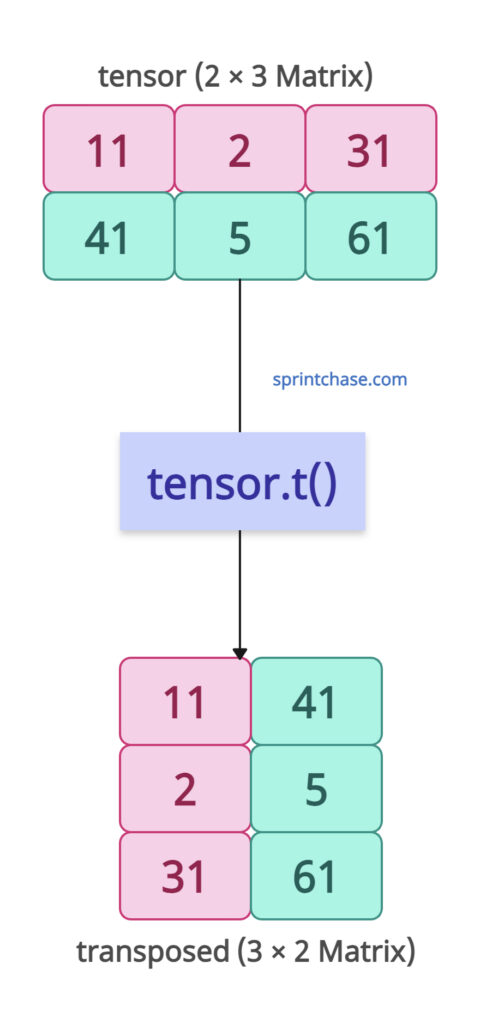The torch.t() method in PyTorch transposes a 2-dimensional tensor, swapping its rows and columns. If the input tensor is a 0D or 1D, it returns it as it is without any changes.
What if your input tensor is 3D or higher dimensional? Well, for that, you can use torch.transpose() or torch.permute() methods.
Syntax
torch.t(input)
Parameters
| Argument | Description |
| input (Tensor) | It is an input 2D tensor. For example, a matrix of shape [m, n]. |
Transpose of a 2D Tensor
Let’s swap a row and column of a 2D tensor.import torch
# Create a 2D tensor (2x3)
tensor = torch.tensor([[11, 2, 31],
[41, 5, 61]])
# Transpose using t()
transposed = tensor.t()
print("Original tensor:\n", tensor)
# Output:
# Original tensor:
# tensor([[11, 2, 31],
# [41, 5, 61]])
print("Transposed tensor:\n", transposed)
# Output:
# Transposed tensor:
# tensor([[11, 41],
# [ 2, 5],
# [31, 61]])
The original tensor’s shape was [2, 3], and after transposing, its new shape is [3, 2]. That shows that columns and rows have been swapped.
In-place transpose with t_()
For memory efficiency, you can use the “t_()” method to modify the tensor in place. In other words, no new tensor is returned.
import torch
# Create a 2D tensor (2x4)
tensor = torch.tensor([[10, 20, 30, 70],
[40, 50, 60, 80]])
print("Original tensor:\n", tensor)
# Output:
# Original tensor:
# tensor([[10, 20, 30, 70],
# [40, 50, 60, 80]])
# In-place transpose
tensor.t_()
print("Transposed tensor:\n", tensor)
# Output:
# Transposed tensor:
# tensor([[10, 40],
# [20, 50],
# [30, 60],
# [70, 80]])
The input tensor’s shape was [2, 4], and the modified in-place tensor’s shape is [4, 2].
Matrix Multiplication
We can use transposing to align dimensions for matrix multiplication.
import torch
# Define two tensors
A = torch.tensor([[1, 2],
[3, 4]]) # Shape: [2, 2]
B = torch.tensor([[5, 6, 7],
[8, 9, 10]]) # Shape: [2, 3]
# Transpose A to make dimensions compatible
result = torch.matmul(A.t(), B) # Shape: [2, 3]
print("Result of matrix multiplication:\n", result)
# Output:
# Result of matrix multiplication:
# tensor([[29, 33, 37],
# [42, 48, 54]])
Error case: Applying t() to Non-2D Tensor
If you attempt to use the t() method on a non-2D tensor, it will raise a RuntimeError.
import torch
# 3D tensor
tensor = torch.randn(2, 3, 4)
try:
tensor.t()
except RuntimeError as e:
print("Error:", e)
# Output: Error: t() expects a tensor with <= 2 dimensions, but self is 3D
Conjugate Transposition (Complex Numbers)
Let’s define a complex tensor and find its conjugate using the torch.conj() and .t() methods.import torch complex_tensor = torch.tensor([[1+2j, 3+4j]]) # Complex tensor conj_transpose = complex_tensor.conj().t() # Conjugate transpose print(conj_transpose) # Output: # tensor([[1.-2j], # [3.-4j]])That’s all!






